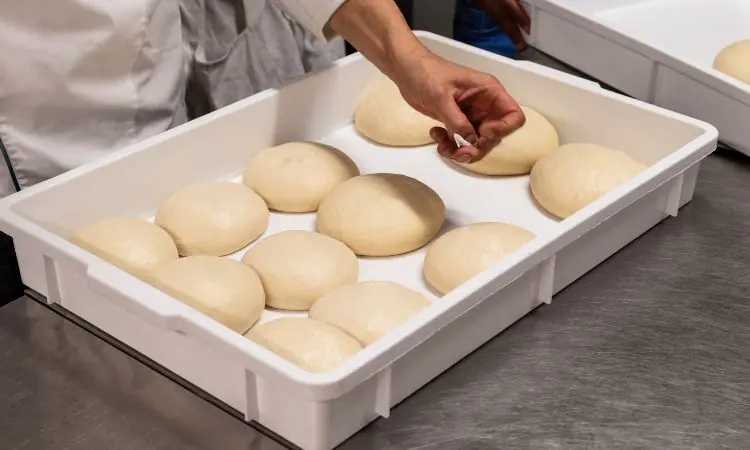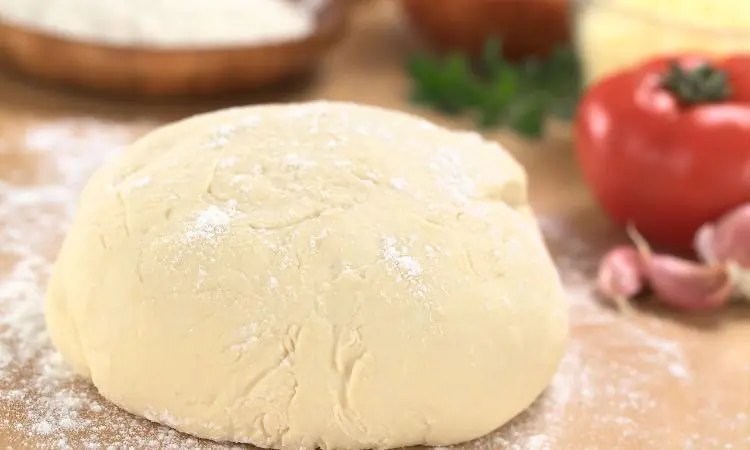The best time to freeze pizza dough is after the first rise and before shaping. Ensure the dough is tightly sealed in a freezer-safe bag.
Freezing pizza dough can be a game-changer for busy food enthusiasts who crave a homemade slice without the prep time. By stashing prepared dough in your freezer, you’re always just a thaw away from fresh pizza. Freezing at the right stage preserves the yeast’s activity, ensuring your crust still boasts that airy, crisp texture once baked.
Remember to label your dough with the date, as frozen pizza dough is best used within three months. Unleashing your inner pizza chef at a moment’s notice becomes effortless and hassle-free with quality dough on standby.

The Art Of Pizza Dough
Making an incredible pizza starts with the perfect dough. The art of pizza dough is a blend of science and patience, turning simple ingredients into a canvas for your favorite toppings. Understanding the best time to freeze pizza dough can set your home-cooked pizza apart from the rest.
The Secret Ingredient: Time
Time is essential in dough development. Fermentation enriches flavor and texture. Fresh dough can be frozen, but allowing it to rest in the fridge for 1 to 2 days before freezing enhances its quality. The cold fermentation period allows the dough to develop a complex flavor profile and a desirable crust that is both chewy and crisp.
- Immediately after kneading: Dough can be frozen but might need more depth in flavor.
- 1 to 2 days in the fridge: Dough develops more flavor–ideal for freezing.
- Post-freezing: Thaw in the fridge for the slow revival of yeast activity.
The Science Of Yeast Fermentation
At the heart of pizza dough is the science of yeast fermentation. Yeast, a living organism, consumes the sugars in flour and releases carbon dioxide. This process makes the dough rise and imparts a delightful texture and taste.
| Temperature | Effect on Yeast Activity |
| Freezing | It slows down but does not kill the yeast. |
| Refrigeration | Yeast activity is reduced, allowing slow fermentation. |
| Room Temperature | Promotes a quicker rise suitable for immediate baking. |
Freezing the dough halts yeast activity temporarily, preserving the dough’s current state. After freezing, a slow thaw in the refrigerator gives the yeast a chance to wake up and continue its work, albeit at a deliberate pace that further improves the character and structure of the crust.

Fresh Vs. Frozen Dough
Deciding between fresh and frozen pizza dough is critical to homemade pizza success. Both options offer unique benefits to fit diverse needs and preferences. Understanding the differences in texture, taste, and convenience helps determine the best time to freeze your pizza dough.
Texture And Taste: A Comparison
Fresh dough brings a distinct yeast flavor and elasticity that can lead to a perfect crust. By contrast, frozen dough might lose some texture qualities after thawing. Yet, proper freezing techniques can maintain its delicious character.
- Fresh Dough: Light, airy, and flavorful when baked right away.
- Frozen Dough: Can be less springy but still tasty if frozen quickly.
Convenience In The Kitchen
Life can get hectic. Freezing dough means always being ready to whip up a pizza. Frozen dough needs thawing, but it saves the time you’d spend on making fresh batches.
| Preparation Step | Fresh Dough | Frozen Dough |
| Availability | Immediate use | Requires planning ahead |
| Time to Pizza | Shorter | Extended due to thawing |
| Shelf Life | Limited | Extended with proper storage |
Both fresh and frozen options enable a delicious homemade pizza experience. Choose based on what works for your taste and schedule.
Freezing Pizza Dough: The Basics
Making pizza at home can be a fun and rewarding experience. Preparing the dough in advance is bright, and freezing it adds convenience. Grasp the essentials of freezing pizza dough to enjoy homemade pizza anytime. Below, find the crucial stages for preserving your dough at its peak quality and the vital tools needed for this simple, efficient process.
Picking The Perfect Point
Timing is everything when freezing pizza dough. Aim to freeze the dough after the first rise. This is when yeast has done its initial work, creating the perfect texture and flavor. By freezing at this stage, the dough maintains its quality. Divide the batch into portions for a single pizza. This makes thawing and usage straightforward.
Essential Equipment For Freezing
Freezing pizza dough requires minimal tools, yet the right ones make a difference. Gather these items for optimal results:
- Plastic wrap: Seal dough tightly to protect it from freezer burn and odors.
- Freezer bags: Store wrapped dough in airtight bags, squeezing out extra air.
- Permanent marker: Date each bag to track how long the dough has been frozen.
Remember to leave space in freezer bags for the dough to expand slightly as it freezes. Use within three months for the best taste and texture.
Ideal Timing For Freezing
Knowing the perfect moment to freeze pizza dough is critical for taste and convenience. Let’s dive into when that moment strikes.
The Right Age Of Dough To Freeze
Freezing dough is a balancing act. Timing plays a key role. A fresh dough is too young. Over-risen dough may not freeze well.
- 1 to 2 hours old: The dough is still too young.
- After the first rise: This is the prime time to freeze.
- Before it doubles in size, start the freezing process.
Reading The Dough’s Readiness
Observing the dough is crucial. Texture and consistency will guide the way.
- Smooth Surface: Indicates good fermentation.
- It should be slightly tacky but not sticky.
- Gently poke: If it springs back slowly, it’s ready.
Freezing Technique Mastery
Freezing pizza dough is straightforward, but doing it right can make a big difference. Perfect your freezing method to enjoy delicious, homemade pizza any day of the week.
Step-by-step Freezing Process
Follow these simple steps to freeze your pizza dough like a pro:
- Prepare the dough – Complete the kneading and let it rise as usual.
- Portion the dough – Divide into the desired sizes. Remember, one ball equals one pizza.
- Oil it lightly – Coat each dough ball with a thin layer of oil. This prevents sticking.
- Wrap it well – Use plastic wrap to cover each ball tightly, which fights off freezer burn.
- Seal in bags – Place the wrapped dough into zip-lock bags. Press out excess air.
- Label your bags – Write the date on the bag. Dough lasts up to three months.
- Freeze – Place bags in the coldest part of your freezer.
Preventing Freezer Burn And Ice Crystals
To keep your dough in the best condition, consider these tips:
- Temperature matters – Keep your freezer at zero degrees Fahrenheit or colder.
- Limit exposure – Work quickly to prevent the dough from warming up.
- Use heavy-duty materials – Invest in quality freezer bags or wraps.
- Double-wrap if needed – Extra protection never hurts. Add another layer of wrap.
- Correct storage – Avoid placing the dough near the door where temperatures vary.
Thawing And Proofing Frozen Dough
Thawing and proofing frozen dough are essential processes in baking. Great pizza starts with the dough. Properly defrosted and proofed dough can be the difference between excellent and outstanding pizza. The methods used can affect the texture and flavor of the pizza. Below, discover the best practices for thawing and proofing your frozen pizza dough.
Optimal Thawing Methods
Thawing pizza dough correctly is crucial for a perfect bake. Here’s how:
- Refrigerator Thawing: Move the dough to the fridge. Let it sit for 12 hours or overnight.
- Counter Thawing: Place the dough on the counter. Cover it with a bowl. Let the dough thaw for 2 hours.
Choose a method based on your schedule. Plan to give the dough enough time to thaw slowly.
Ensuring The Rise After Freezing
The thawed dough must still rise. Here’s how to ensure a good rise:
- Temperature Check: Ensure the room temperature is warm.
- Proofing Box: If available, use a proofing box. Set it to 75-85°F.
- Bowl and Cloth: If there is no box, place the dough in a bowl. Cover with a damp cloth. A cloth keeps the dough moist.
- Patience is Key: Allow the dough to double in size. This may take 1 to 2 hours.
Always let the dough rise until it’s puffy. This makes for a light and airy crust.
Maximizing Dough Usage Post-freezing
Freezing pizza dough saves time and extends the fun of homemade pizza night. Unfreeze the dough correctly to enjoy the best taste and texture. Read on for essential tips on handling and cooking your frozen pizza dough.
Handling And Shaping Tips
Thaw dough slowly in the fridge for the best results. Moving from cold to room temperature too quickly can affect texture. Once thawed, let the dough rest at room temperature for about 30 minutes. This makes shaping easier and prevents tearing.
- Handle gently to keep air bubbles.
- Use flour on surfaces to prevent sticking.
- Don’t roll the dough; stretch it by hand for a better texture.
- Avoid overworking the dough; it should be soft and pliable.
Adjusting Cooking Times And Temperatures
Post-freezing, the dough could take longer to cook. A fully preheated oven is crucial. Use a pizza stone or baking sheet for even heating. Test kitchen temperatures as ovens vary widely.
| Oven Type | Temperature | Time Increase |
| Conventional | 475°F | 2-3 mins |
| Convection | 450°F | 1-2 mins |
- Preheat the oven for at least 30 minutes.
- Place the pizza on the lowest rack.
- Monitor closely and adjust time as needed.
Pizzas may need an extra minute or two in the oven compared to fresh dough. Watch for a golden crust and melted cheese as signs of readiness.

Common Mistakes To Avoid
Freezing pizza dough is a great way to save time. But careful! Some common mistakes can ruin the dough. Let’s make sure you get the perfect homemade pizza every time by avoiding these errors.
Over-proofing Pitfalls
Pizza dough gets hurt by over-proofing. This happens when the dough rises too long. The result? Bad textures and flavors. You want to catch the dough when it’s just doubled in size. Not any bigger.
- Watch the clock – time the proofing.
- Look at the size – it should double, not triple
- Do the poke test – a gentle poke should leave a mark
Temperature Mismanagement
Temperature is critical when freezing dough. Too hot or too cold, and you’ve got problems. Find that sweet spot for just the right freeze.
| Temperature | What it Does |
| Too Cold | Stops yeast; dough doesn’t rise |
| Too Warm | Speeds yeast up, dough over proofs |
| Just Right | Freezes slowly, preserves texture |
Always cool the dough gradually. Aim for a fridge chill before the freeze. Use an airtight bag or container to keep moisture in.
Recipe Variations For Freezer-friendly Dough
Exploring the perfect time to freeze pizza dough opens the door to an array of recipe variations for freezer-friendly dough. Consider this your ultimate guide to locking in the freshest flavors and perfect textures of homemade pizza dough. Whether you’re a seasoned chef or a spontaneous home cook, you’ll find tailored recipes here that ensure your frozen dough rises to the occasion every time.
Enhancing Flavor And Texture
Before freezing your dough, it’s essential to think about the impact on flavor and texture. Enhanced dough recipes can withstand freezing temperatures and still deliver exceptional taste and quality. Here are some tips:
- Increase the yeast: Use a bit more yeast than usual to counteract any loss in rising power after thawing.
- Add sugar or honey: A touch of sweetness not only adds flavor but also helps boost yeast activity.
- Consider fat content: Adding a small amount of olive oil can improve the dough’s moisture retention.
Custom Dough Recipes For Freezing
Creating a custom dough recipe tailored for freezing can make all the difference. These recipes are designed with the freezer in mind:
| Ingredients | Standard Recipe | Freezer Recipe |
| Flour | 3 cups | 3 cups |
| Yeast | 1 tsp | 1 ¼ tsp |
| Sugar/Honey | Optional | 1 tbsp |
| Water | 1 cup | 1 cup, warm |
| Olive Oil | 2 tbsp | 3 tbsp |
Once you mix your ingredients, knead the dough until smooth. Let it rise until it is doubled. After the first rise, portion the dough for freezing. Roll the portions into balls and coat lightly with oil before placing them into freezer bags. They can be frozen for up to 3 months. Thaw overnight in the refrigerator before use and allow the dough to come to room temperature before stretching into pizzas. Each variation ensures your creations maintain the desired flavor and texture, so every pizza is as delicious as the last.
Frequently Asked Questions Of When Is The Best Time To Freeze Pizza Dough
At What Stage Do You Freeze Pizza Dough?
Freeze pizza dough after the first rise, once you’ve divided it into portions, and before the second rise. Seal the portions tightly in freezer bags.
Do You Freeze Dough Before Or After It Rises?
Freeze dough after it has risen fully to preserve yeast activity and bread quality. Thaw completely before baking.
Does Frozen Pizza Dough Need To Rise?
Yes, defrosted frozen pizza dough should rise until it doubles in size for optimal texture. Allow it to warm and expand at room temperature before baking.
Should I Thaw Frozen Pizza Dough Before Baking?
Yes, thaw frozen pizza dough before baking for the best results. Allow it to reach room temperature, usually taking a few hours.
Conclusion
Determining the optimal time to freeze pizza dough is crucial for any home chef. Aim to do it after the first rise for best results. This preserves the yeast’s power, ensuring a perfect crust every time. So, next time you’re meal prepping, remember: post-rise, pre-shape—that’s the dough-freezing sweet spot!

As the author of the “Ultimate Pizza Guide: Recipes, Tips & Secrets Revealed,” I’m dedicated to sharing my love for pizza and empowering others to create delicious homemade pizzas with ease. Join me on a journey to uncover the secrets to perfecting your pizza game!


